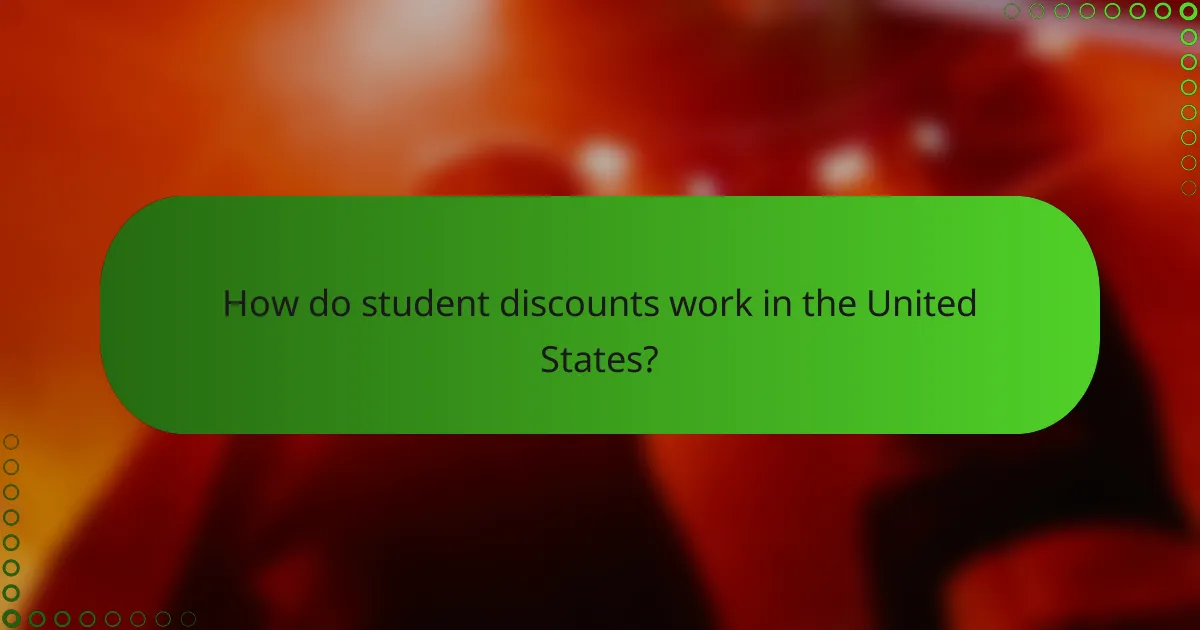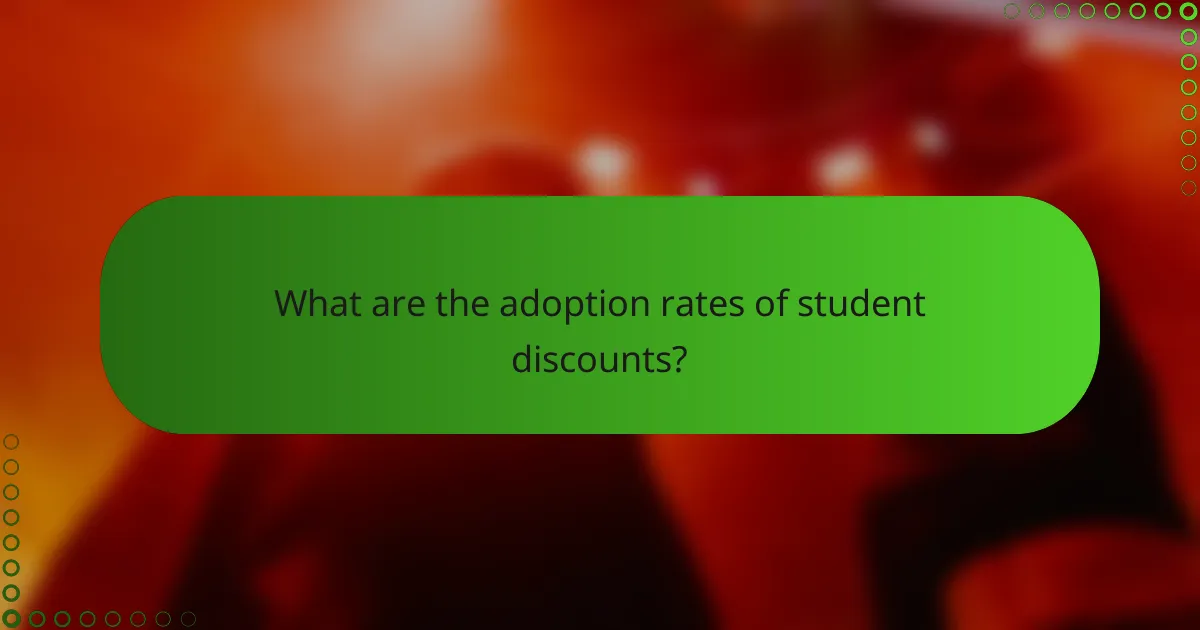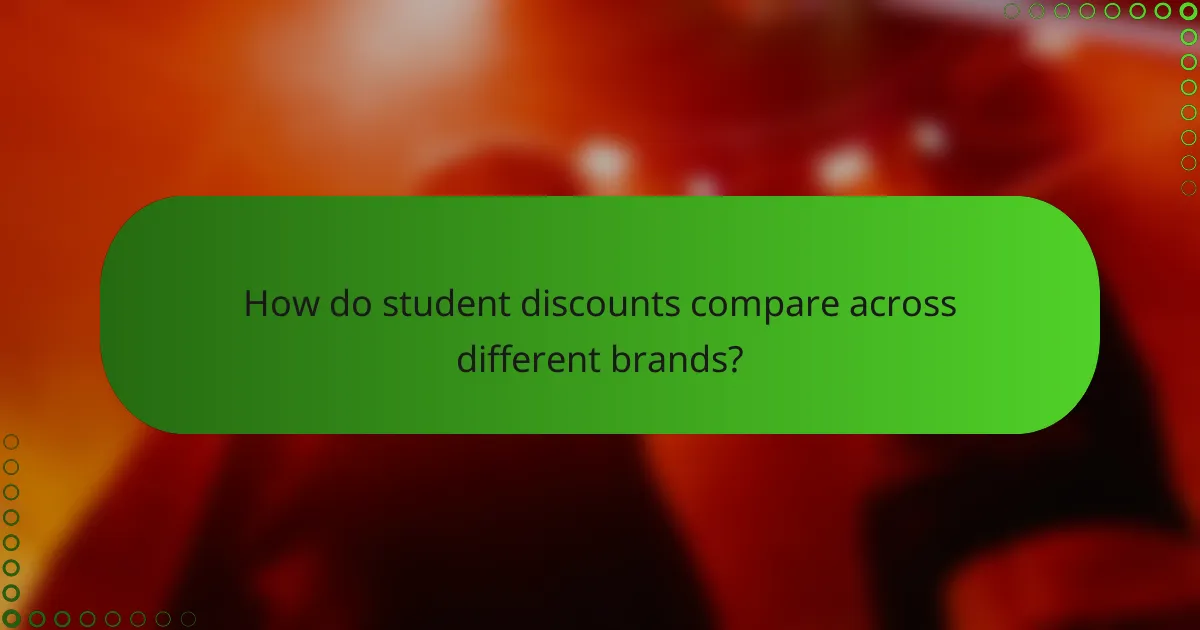Student discounts in the United States offer valuable financial relief for eligible students, enabling them to save on a wide range of products and services. With proof of student status, such as a student ID, many students actively seek these discounts, which can lead to savings of 10% to 50%. This financial benefit is particularly impactful in managing both educational expenses and everyday costs.

How do student discounts work in the United States?
Student discounts in the United States provide financial benefits to eligible students, allowing them to save on various products and services. Typically, these discounts require proof of student status, such as a student ID or enrollment verification.
Eligibility criteria for student discounts
To qualify for student discounts, individuals generally need to be enrolled in an accredited educational institution, such as a college or university. Most companies require students to provide a valid student ID or an email address associated with their school.
Some discounts may have specific age limits or be restricted to undergraduate or graduate students. It’s essential to check the terms and conditions of each discount to ensure eligibility.
Common types of student discounts
Student discounts can be found across various sectors, including technology, travel, entertainment, and retail. Common offerings include reduced prices on software, discounted public transportation fares, and lower rates for movie tickets.
Additionally, many online platforms provide subscription discounts for students, such as streaming services and educational resources, often ranging from 10% to 50% off regular prices.
Examples of companies offering student discounts
Numerous companies provide student discounts, making it easier for students to save money. Popular examples include Apple, which offers discounts on devices and software, and Spotify, which provides a significant reduction on premium subscriptions for students.
Other notable companies include Adobe, offering discounts on creative software, and various clothing retailers like ASOS and H&M, which often have special promotions for students. Checking each company’s website or signing up for newsletters can help students stay informed about available discounts.

What are the adoption rates of student discounts?
Adoption rates of student discounts vary widely, but many students actively seek and utilize these offers to save money on essential goods and services. Research indicates that a significant percentage of students, often exceeding half, take advantage of discounts available to them, particularly in sectors like retail and technology.
Statistics on student discount usage
Approximately 60-70% of students report using student discounts regularly, especially for online purchases and subscriptions. Popular platforms like Amazon and Spotify offer notable discounts, which contribute to high usage rates among students. Additionally, many retailers provide exclusive deals during back-to-school seasons, further boosting adoption.
Surveys show that students save an average of 10-20% on purchases when using discounts, translating to substantial savings over time. For example, a student spending $1,000 annually on textbooks could save $100-$200 through discounts.
Demographics of students utilizing discounts
Student discounts are predominantly utilized by undergraduate students, with younger students aged 18-24 being the most active users. This demographic often faces financial constraints, making discounts particularly appealing. Graduate students also benefit from discounts, though their usage may be less frequent due to different spending habits.
Geographically, students in urban areas tend to utilize discounts more than those in rural regions, likely due to greater access to participating retailers and services. Additionally, international students often seek discounts as a way to manage living expenses in a new country.

How much can students save with discounts?
Students can save a significant amount through various discounts, often ranging from 10% to 50% depending on the category and provider. These savings can make a considerable difference in managing educational expenses and everyday costs.
Average savings from student discounts
The average savings from student discounts typically fall between 15% and 30% across various sectors. For example, many retailers and online services offer discounts that can help students stretch their budgets further.
Some platforms, like Amazon Prime, provide exclusive student rates that can lead to substantial annual savings. It’s advisable for students to compare offers and take advantage of multiple discounts to maximize their savings.
Top categories for student savings
Students can find discounts in several key categories, including technology, clothing, and entertainment. For instance, many software companies offer educational pricing on tools like Adobe Creative Cloud and Microsoft Office.
Additionally, retailers in the fashion industry often provide student discounts, which can be particularly beneficial for those looking to update their wardrobes. Subscription services for streaming platforms frequently offer reduced rates for students, making entertainment more affordable.

What are the eligibility requirements for student discounts?
To qualify for student discounts, individuals typically need to provide proof of enrollment in an accredited educational institution. This proof can vary by provider but generally includes a student ID, enrollment letter, or a school-issued email address.
Proof of enrollment needed
Most businesses require valid proof of enrollment to access student discounts. This can include a current student ID card, an official letter from the school, or a school email address that confirms your student status. Always check the specific requirements of each provider, as they may vary.
Some online platforms may allow you to verify your student status through third-party services like UNiDAYS or Student Beans, which streamline the process for both students and businesses.
Age and location restrictions
Eligibility for student discounts can also depend on age and geographic location. Many discounts are aimed at college or university students, typically between the ages of 18 and 24. However, some discounts may extend to high school students or even non-traditional students of any age.
Location can affect availability; for instance, certain discounts may only apply in specific countries or regions. Always verify the terms and conditions to ensure you meet the age and location criteria for the discounts you seek.

How do student discounts compare across different brands?
Student discounts vary significantly across brands, often reflecting the company’s marketing strategy and target audience. Many brands offer discounts ranging from 10% to 25%, but the actual savings depend on the specific products or services being purchased.
Comparison of popular brands offering discounts
Several well-known brands provide student discounts, including Apple, Spotify, and Adobe. For instance, Apple offers education pricing on select products, while Spotify provides a discounted subscription rate for students. Adobe’s Creative Cloud also features a significant student discount, making it more affordable for those pursuing creative studies.
It’s essential for students to verify eligibility requirements, as some brands may require proof of enrollment or a valid student email address. Checking each brand’s website for specific terms can help ensure that students maximize their savings.
Variations in discount percentages
Students should keep an eye out for seasonal promotions or special events, as these can enhance savings beyond standard discount rates. Signing up for newsletters or following brands on social media can also provide alerts on limited-time offers tailored for students.

What are the challenges in accessing student discounts?
Accessing student discounts can be difficult due to various barriers such as lack of awareness and limitations within the programs themselves. These challenges can prevent students from maximizing their potential savings.
Awareness and accessibility issues
Many students are simply unaware of the discounts available to them, which can lead to missed opportunities for savings. Institutions and retailers often do not effectively communicate these offers, leaving students uninformed.
Additionally, some discounts may require specific identification or verification processes that can be cumbersome. For instance, students may need to present a valid student ID or register on a website, which can deter them from utilizing the discounts.
Limitations of student discount programs
Student discount programs often come with restrictions that can limit their usefulness. For example, discounts may only apply to certain products or services, or they may be available only during specific times of the year.
Moreover, some discounts are not substantial enough to make a significant impact on a student’s budget. While a 10% discount might seem appealing, it may not be enough to sway a purchasing decision, especially for larger expenses like textbooks or technology.

What are the future trends in student discounts?
Future trends in student discounts indicate a growing integration of technology and personalized offerings. As more companies recognize the value of targeting students, discounts are becoming more accessible through digital platforms and tailored promotions.
Emerging platforms for student discounts
New digital platforms are reshaping how students access discounts. Apps and websites dedicated to student savings are gaining popularity, allowing users to find deals from various retailers in one place. These platforms often require verification of student status, ensuring that discounts reach the intended audience.
For example, platforms like UNiDAYS and Student Beans offer exclusive discounts on popular brands, ranging from clothing to technology. Students can save anywhere from 10% to 30% on purchases, making these platforms valuable resources for budget-conscious individuals.
When using these platforms, students should ensure they are aware of the verification process, which may involve using a university email address or uploading student ID. Additionally, it’s wise to compare offers across different platforms to maximize savings.









